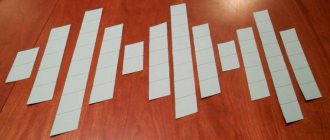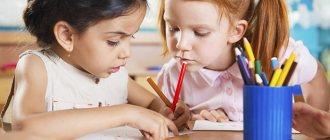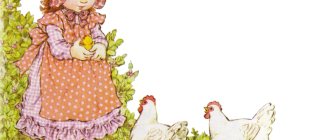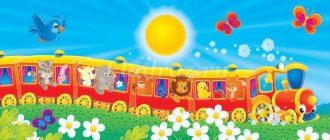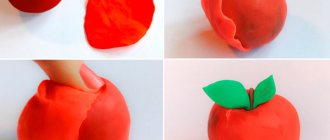Arithmetic classes for older preschoolers in kindergarten
The material in this section represents the teacher’s experience working with children in their sixth year of life.
Lesson notes are aimed at developing the mathematical abilities of preschool children.
Mastering program material occurs through games, game exercises, and game situations. The main focus of the exercises is on finding independent ways to achieve the intended goals.
Notes for classes with children of the sixth year of life are built taking into account the method of forming simple mathematical concepts by A.M. Leushina and A.A. Carpenter. This methodology pays attention not only to the training of preschoolers, but also to the improvement of their cognitive activity and general intellectual development.
It is recommended to consider the following as the main tasks in the development of a child’s mathematical abilities:
• activation of thought processes;
• stimulation of active cognitive interests;
• formation of visually effective and visually imaginative thinking;
• improvement of speech skills.
The manual contains many examples from fiction: riddles, poems. Heroes of fairy tales, cartoons, original works in the form of toys, illustrations are frequent guests of the classes. Their implementation creates enthusiasm for the process of learning arithmetic.
To successfully teach arithmetic to kids, you don't need expensive equipment. All that is needed for classes are objects of the surrounding reality, illustrations, models, diagrams, and didactic material available at the preschool educational institution, both factory-produced and self-produced.
It is better to conduct classes in subgroups. This helps to improve learning properties and the formation of a creative personality. The teacher will be able to carry out personal work when forming groups of children of different levels of development. For children with a higher level of development, the load (in the form of additional material) will increase. For children with a lower level of development, the teacher will give the least amount of workload.
Organizing classes involves different options for bringing kids together. Depending on their goals, they can unite in pairs, threes, or sixes. This will help them actively engage in group play and successfully complete creative tasks.
Classes are held once a week. The exception is pre-school holidays: the last week of December and the 1st week of January.
To consolidate mathematical knowledge and skills, it is not recommended to limit yourself to classes. You can create game mathematical situations in your free time from class.
If a program task is difficult for children to master, it is necessary to organize a game, exercises, and a situation with this task before class. This will prepare your child to master the program material.
Not all problems in the mathematical section of the program can be solved using exercises. Some of them will be better learned during role-playing games, didactic games or on walks.
Class notes from this manual should not be copied 100% by teachers. You can take or not take a certain game, you can add or remove any exercises. Focus on your own kids and their capabilities. What can be done with one audience is impossible with another.
I hope that this manual will help you in your work on developing mathematical capabilities in children.
Problems of mathematical development of children of the sixth year of life
Characteristics
1. Form ideas:
• about the length of the object;
• geometric shapes: circle, oval, triangle, rectangle, square;
• geometric bodies: ball, cube, cylinder.
2. Give an introduction:
• about the weight of the item;
• about volume, depth;
• about the tops, corners, sides of geometric figures;
• about the concepts of “quadrangle”, “triangle”.
3. Learn to systematize geometric shapes, change the principle of systematization.
Affairs
• arrange items by quantity, size, weight, etc.;
• do things between numbers;
• determine your location among environmental objects;
• navigate in space.
2. Create a presentation:
• about the relationship between the whole and the part when dividing an object into several parts;
• about the plan as a reduced modeled relationship between objects in space.
3. Consolidate knowledge about temporary relationships: day, week, month.
Numbers and figures
• quantitative counting of objects within the first 10;
• ordinal counting of objects within the first 10;
• knowledge of numbers from 0 to 9;
• knowledge of the composition of numbers from units;
• knowledge about coins.
2. Give an idea of number as a result of measuring length, weight, time.
3. Learn to establish connections and dependencies between numbers (more, less, equal).
Saving quantity, magnitude
• about the invariance of number as a result of the configuration of the method of placing objects in space;
• about the constancy of the volume as a result of the transfusion carried out;
• about the constancy of the weight as a result of the carried out act of shifting;
• about changes in value depending on the increase or decrease in volume;
• about a change in value depending on the addition or decrease of quantity.
Sequencing
• do actions based on a sign (arrow, arrows);
• discover logical connections between successive steps of an action.
Speech skills
• use words from special terminology in speech: size, color, shape, figure, outside, inside, some, all, etc.;
• name all the characteristics inherent and not inherent in objects (small, not reddish, not square, etc.);
• reflect in speech the basis of grouping and systematization;
• speak without the help of others about the quantity, methods and results of actions;
• explain the sequence and stages of implementation.
The section presents lesson notes on the development of mathematical abilities in older children, which contain game situations, educational and game tasks, and methods of working with children on exercises.
The material in this section is aimed at standard preschool education and can be used in kindergartens working according to different programs.
The materials are addressed to teachers of preschool institutions and parents.
GCD for FEMP In the senior group “Number 0. Digit 0” Author: Perevoshchikova Galina Valentinovna teacher of the preschool group of the Nikolo-Kormskaya Secondary School Description of the material: I offer for you a summary of specific educational activities on the formation of simple mathematical concepts for children in the senior group (5-6 years old )on the topic “Number 0. Number 0.” Development of a scenario for an educational situation in a senior group on the topic: “Number 0. Number 0.” Purpose: 1) To form an idea of the number, to introduce.
Abstract of GCD for FEMP “An entertaining journey to the land of Knowledge.” Senior preschool age Goal: development of computing abilities. Educational tasks: - exercise kids in forward and backward counting within 10, learning the neighbors of the numbers of the first 10; - consolidate quantitative and ordinal numbers in speech; - strengthen the ability to navigate in space and time; - consolidate the ability to distinguish and correctly name geometric shapes; — consolidate knowledge of traffic rules; - owl.
Summary of arithmetic classes at the preschool educational institution “Interesting Mathematics.” Senior groupAuthor: Natalia Aleksandrovna Kovtun, teacher at MBDOU kindergarten “Teremok” p. Izhevskoe, Ryazan region. Description of the material: This summary may be needed by preschool teachers working with children of senior preschool age. The tasks presented in the notes are playful and accessible to children aged 5-6 years. Goal: Formation of simple mathematical concepts in preschoolers. Objectives: 1. Exercise the kids.
Summary of a lesson for children of senior preschool age “Wonderful Country of Mathematics” Goal: Activation of cognitive activity of children. Objectives: - Improve knowledge of geometric shapes. — Continue teaching preschoolers to solve addition and subtraction problems. - Maintain serial counting. — Develop logical thinking, attention, intelligence. Equipment: colored cardboard, scissors, sets of geometric shapes, envelopes with a set of numbers, handouts, ball. 1. Regulation
Summary of GCD for FEMP in kindergarten. Senior preschool age. Topic “Journey to the Forest” Goal: Creating criteria for developing enthusiasm for the subject of mathematics, based on cognitive activity and curiosity, consolidating and generalizing acquired knowledge. Objectives: Educational. • Summarize and classify knowledge according to FEMP in the pre-school group. • develop cognitive enthusiasm and motivation for learning activities, through the inclusion of various game tasks: a guideline.
Joint activity in arithmetic for 5-year-old children “Visiting the naturalist grandfather” Objectives: Educational: to promote motivation for activity. Developmental: developing the ability to help each other. Educational: Children will master the actions of constructing models of quantitative relationships (in the form of two groups of substituents, arranged according to the principle of mutually specific correspondence), used to compare two sets of objects. Equipment: two sheets of paper with seven-nine inches pasted on one.
Abstract of specifically educational activities in the educational field “Cognition” for children of senior preschool age. Topic: Visiting the Queen “Mathematics” Purpose: Identification of simple mathematical knowledge, concepts, and skills acquired by children during the school year. Educational Objectives - To develop the ability of quantitative, ordinal and revolving accounts within the limits of 10; -Clarify spatial matters on, above, left, right, behind, in front, above, below. Exercise in.
Abstract of GCD on the formation of simple mathematical concepts “Numbers from 1 to 10” Author: Mubarakzyanova Serine Vrezhikovna, junior teacher of the City economical preschool educational institution “Kindergarten “Fairy Tale”, Muravlenko, Yamalo-Nenets Autonomous Okrug. Description: The lesson is aimed at developing simple mathematical concepts in children of senior preschool age using information technology. The purpose of the lesson is to repeat the formation of numbers in the previous one.
Lesson on FEMP in the senior group of preschool educational institutions Author: Anna Nikolaevna Voronkova Description of the material: This material will be fascinating and useful for teachers of senior preschool age. Summary of the final lesson in arithmetic in the senior group “Let's Help Buratino”. Final lesson in arithmetic in the senior group “Let's Help Pinocchio”. Goals: 1. Strengthen counting abilities within 10, continue to form spatio-temporal representations (right, left, up, down ), improving abilities orient.
Abstract of GCD in arithmetic in the senior group of preschool educational institutions Program content: - to form an idea of the table, row and column, primary experience of definition and expression in speech, the place of a figure in the table; - train counting skills, the ability to determine and name the shape, color and size of flat geometric shapes, use the spatial relationships “left” - “right”, “above” - “below”; — to form the experience of independently overcoming difficulties under the guidance of a teacher based on reflexes.
Arithmetic lesson in the senior group “Squirrel visiting the kids” I present to your attention a summary of the educational activity on FEMP with the introduction of ICT with children of the senior group. This material will be useful to preschool teachers. Goal: To classify and consolidate the knowledge of children. Objectives: Educational: to generalize and classify the knowledge of children in counting within 10; improve the ability to determine the position of objects in space; consolidate the ability to distinguish and correctly name subsequent geometric ones.
A game-activity for the formation of simple mathematical concepts “Journey to the country of Figurland” for children of senior preschool age Goals: To learn to distinguish and name familiar shapes of objects; Attach geometric shapes; Associate two huge quantities; Expand spatial concepts: in front, behind, behind, between, next to; Practice counting by ear; Enrich children's knowledge about the days of the week; Strengthen your knowledge of numbers; Develop spatial thinking, logical operations.
Open educational activity on the formation of simple mathematical concepts in the senior group “Kolobok’s Journey” Topic: Formation of the number 8. Didactic goal: To form children’s understanding of how the number 8 appears. Objectives: To consolidate the ability to count within 10; consolidate the ability to associate a huge number of objects, equalize them; learn to distinguish geometric shapes (circle, oval, square). Develop logical thinking, memory, imagination. Educate yourself independently.
Abstract of educational activities in the senior group of kindergarten: Journey to the land of mathematics Educational area: “Cognitive development.” Integration of educational areas: social and communicative development, speech development, physical development. Type: integrated. Children's age: 5-6 years. Forms of specific educational activities: motor, play, communicative. Form of organization: subgroup. Tasks: O.
Synopsis of a specific educational activity for the development of mathematical concepts in the senior group “We are treasure hunters.” Description of the material: I bring to your attention a summary of a specific educational activity for the development of mathematical concepts in the senior group. The material will be useful to educators and parents. Integration of educational areas: Knowledge, Communication. Goal: formation of simple mathematical concepts. Objectives: Educational: consolidation.
Work program on arithmetic on the topic: L.S. Metlina "Mathematics in kindergarten".
Contents: 2nd JUNIOR GROUP
METHOD OF FORMING SIMPLE MATHEMATICAL CONCEPTS IN CHILDREN IN THE 2nd YOUNGER GROUP
METHOD OF FORMING SIMPLE MATHEMATICAL CONCEPTS IN KIDS IN THE MIDDLE GROUP
METHOD OF FORMING SIMPLE MATHEMATICAL CONCEPTS IN KIDS IN THE SENIOR GROUP
METHOD FOR FORMING SIMPLE MATHEMATICAL CONCEPTS IN CHILDREN IN THE PRELIMINARY GROUP
Preparatory viewing:
To use the preparatory viewing, create a Google account for yourself and log in:
Library of old Soviet mathematics textbooks
PREFACE
Changes in the content of schooling have significantly increased the requirements for the level of mathematical understanding of kindergarten graduates.
The need to establish continuity in the work of kindergarten and school is reflected in the title of the book - “Mathematics in Kindergarten”.
The concepts of natural numbers, geometric figures, quantities, etc., which children have to learn in school, are abstract, but they reflect the connections and relationships inherent in objects in the outside world.
The primary source of knowledge is sensory perception derived from experience and observation. In the process of sensory cognition, ideas are formed - images of objects - their properties and relationships.
Understanding the logical definitions of concepts is directly dependent on how children go through the first sensory stage of cognition.
The richer their ideas about the quantitative and spatial properties and relationships of real objects, the easier it will be for them in the future to move from these ideas to mathematical concepts through generalization and abstraction.
Successful mastery of mathematical concepts is directly dependent on the development of perception, i.e., sensory development of children. The very ability to generalize and abstraction develops on the basis of the practice of identifying the properties of real objects, comparing and grouping them according to the selected properties. Therefore, special work on the formation of mathematical concepts is carried out throughout preschool childhood in close connection with all educational work in kindergarten.
Children receive elementary ideas about set and number, about the relationships of quantities, about the simplest geometric figures, about the main spatial directions and relationships between objects, about the duration of certain time periods (days, weeks, months). They master ways of identifying quantitative and spatial relationships: practical comparison of numbers of sets (overlapping, applying, pairing, using labels, etc.), comparing the sizes of objects, counting and measuring quantities.
h
Learning to measure quantities allows you to deepen the concept of number. When learning to count, preschoolers often develop an incompletely correct approach to estimating quantities. The unit is perceived by them as a separate object, separateness, outside of its quantitative content.
In the process of measurement, the unit of measurement (measurement) seems to split the measured quantity (length, volume) into parts, each of which is equal to it. The number obtained as a result of measurement clearly acts as an indicator of the relationship between the whole and its part. Measurement emphasizes the relativity of a number, its dependence on the size of the chosen measure: the larger the measure, the smaller the number obtained as a result of the measurement. Teaching children not only to count, but also to measure, develops in them a correct approach to estimating quantities and allows them to further reveal the meaning of generally accepted measures of measurement, which they will become familiar with at school.
Preschoolers learn a small number of mathematical terms: the names of geometric shapes (circle, square, etc.), elements of shapes (angle, side), and computational operations (add, subtract, turn out, equal). The teacher begins to use words such as quantity, number, figure when working with children of the middle group, but does not strive to ensure that the children use them. They learn the meaning of these words gradually, as they accumulate relevant experience. It is unacceptable to replace “difficult” words with “easier” but inaccurate ones. This leads to the formation of misconceptions. The teacher does not use words such as set, aggregate, element, geometric, model, diagonal when working with children. Children learn to reflect mathematical connections, relationships, and actions in clear, concise formulations. They develop an interest in mathematical knowledge and the ability to demonstrate strong-willed efforts to solve problems of a mathematical nature. Much attention is paid to the development of initial skills of inductive and deductive thinking, mental operations: analysis, synthesis, comparison, the ability to abstract and generalize, ingenuity and ingenuity, spatial concepts and imagination.
Children are given mathematical knowledge in a certain system and sequence, while the dose of new things should be small and manageable for assimilation. Therefore, each task is divided into smaller parts, which are studied sequentially.
New material from any of the sections of the program (“Quantity and Counting”, “Value”, “Form”, etc.) is sequentially studied in 2-5 lessons, first in the first part, and later in the second. In the future, they return to repetition after 2-3 weeks. The period of returning to the past is increasingly increasing. However, each studied program task should be in the field of view of the teacher until the end of the school year.
The teacher must know how the program for each age group is structured. This will make it possible not only to determine the level of mathematical development of children in their group, but also to present the role and place of each lesson in the system of all work on the development of elementary mathematical concepts in preschoolers.
The main form of work on the formation of mathematical concepts is classes. During the classes they solve most of the software problems. Children form ideas in a certain sequence and develop the necessary skills and abilities.
Great importance is attached to the organization of observations of the quantitative side of the environment, the use by children of knowledge and skills of mathematical content in various types of children's activities.
Didactic games and gaming exercises are widely used in classes and in everyday life. By organizing games outside of class, they consolidate, deepen and expand children’s mathematical understanding. In some cases, games carry the main educational load, for example, in developing spatial orientation.
Children who have missed more than one lesson are dealt with individually to prevent them from falling behind the rest of the children.
Particular attention is paid to individual lessons with those children who, due to their developmental characteristics, cannot learn new knowledge in class on an equal basis with everyone else. They are worked with somewhat ahead of schedule in order to prepare them for work in the classroom.
The active activity of children in the classroom is ensured, first of all, by the correct combination of work on new and repeated material, alternating types of work and forms of its organization, i.e., the structure of the lesson.
The structure of the lesson is determined by the volume, content, combination of program tasks, the level of acquisition of relevant knowledge and skills, and the age characteristics of the children.
Studying new material includes three types of work: firstly, the teacher shows and explains new tasks, demonstrates a sample, identifying the properties and connections of mathematical objects. Children observe the actions of the teacher, listen to his instructions, explanations, and answer questions;
secondly, some children perform individual tasks under the direct supervision of the teacher, others observe the actions of a friend, listen to him, make corrections, supplement, answer questions;
thirdly, children independently work with handouts, mastering new skills.
In the first lesson, all three types of work can be used, then learning a new one takes up most of the time. On
In another lesson, learning something new takes half the time limit, the second is devoted to repeating what has been learned. Children’s independent work with handouts is planned for the next lesson and half of the time is allocated to this.
In the junior and middle groups, they are limited to working on topics I-2, so classes consist of 2-3 parts. In senior and preparatory groups, classes consist of 3-4 parts, since work is carried out on 2-3 topics.
The content of the classes determines the organization of their implementation. It is important that when explaining new material, all children see the actions of the teacher or child. Later, to consolidate knowledge and skills, tasks are given to all children at the same time. They work at the table either facing the teacher, or sideways, but in no case with their backs, since when checking the completion of a task, the teacher constantly draws the children’s attention to the model, to various kinds of visual aids.
No more than 4 children are seated at six-seat tables; if necessary, an additional 1-2 tables are placed. If it is necessary to check how children have acquired knowledge and skills, work with preschoolers is organized at the teacher’s desk. When exercises related to movement (outdoor games, etc.) are given during a lesson or at the end of it, the place for them is prepared in advance.
The methodology for working with children of each age group is presented in separate chapters. The description of methods and techniques for working in sections of the program is preceded by general recommendations for teaching children of this age in mathematics classes.
Lesson notes are included with each chapter. They should only be considered as possible options. In no case should this exclude the creativity of educators, since it is obvious that there are no universal techniques that would be suitable for working with children of any group. Stencils should not be allowed in the work or formal use of the material.
To help the teacher act depending on specific conditions, various techniques are given that allow one to successfully solve the same program tasks. When preparing for a lesson, the teacher carefully considers its content, taking into account the knowledge and skills of his pupils, decides how to more effectively use certain methods and techniques, and visual material. It provides children with the opportunity to take initiative in acquiring and applying knowledge, stimulates their ingenuity and intelligence, and encourages them to use mental actions.
The search and application of teaching methods that ensure not only the formation of mathematical concepts in children, but also the development of mental functions (perception, memory, thinking, imagination) is the key to successfully preparing children for learning mathematics at school.
